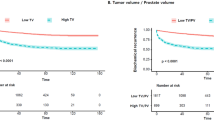Abstract
The aim of this study was to investigate the potential prognostic value of preoperative serum prostate-specific antigen levels adjusted for total tumor volume (PSA-TTV density) for outcome following radical prostatectomy for prostate cancer by retrospective review in 268 patients. Lower PSA-TTV density was not only associated with a significantly higher risk for biological failure (bF), systemic failure and cancer death but also an independent predictor for bF (hazard ratio, 6.3). Therefore, these data suggest that there are subsets of prostate cancer with lower PSA secretion levels, and this phenotype is associated with a higher risk of failure after surgery.
This is a preview of subscription content, access via your institution
Access options
Subscribe to this journal
Receive 4 print issues and online access
$259.00 per year
only $64.75 per issue
Buy this article
- Purchase on Springer Link
- Instant access to full article PDF
Prices may be subject to local taxes which are calculated during checkout



Similar content being viewed by others
References
Ohori M, Wheeler TM, Dunn JK, Stamey TA, Scardino PT . The pathological features and prognosis of prostate cancer detectable with current diagnostic tests. J Urol 1994; 152: 1714–1720.
Ingenito AC, Ennis RD, Hsu IC, Begg MD, Benson MC, Schiff PB . Re-examining the role of prostate-specific antigen density in predicting outcome for clinically localized prostate cancer. Urology 1997; 50: 73–78.
Freedland SJ, Kane CJ, Presti Jr JC, Terris MK, Amling CL, Dorey F et al. Comparison of preoperative prostate specific antigen density and prostate specific antigen for predicting recurrence after radical prostatectomy: results from the search data base. J Urol 2003; 169: 969–973.
Partin AW, Carter HB, Chan DW, Epstein JI, Oesterling JE, Rock RC et al. Prostate specific antigen in the staging of localized prostate cancer: influence of tumor differentiation, tumor volume and benign hyperplasia. J Urol 1990; 143: 747–752.
Stamey TA, Caldwell M, McNeal JE, Nolley R, Hemenez M, Downs J . The prostate specific antigen era in the United States is over for prostate cancer: what happened in the last 20 years? J Urol 2004; 172: 1297–1301.
Egawa S, Matsui Y, Matsumoto K, Suyama K, Arai Y, Kuwao S et al. Impact of biochemical failure on long-term clinical outcome after radical prostatectomy for prostate cancer in Japan. Prostate Cancer Prostatic Dis 2004; 7: 152–157.
Machida T, Ohishi Y, Wada T, Akimoto S, Shimazaki J, Oda H et al. Clinical evaluation of a new kit (IMX PA Dainapack) for detection of serum prostate specific antigen. Hinyokika Kiyo 1993; 39: 977–984.
UICC International Union. In: Sobin LH, Wittekind CH (eds). UICC International Union Against Cancer, TNM classification of malignant tumors, 6th edn. John Wiley & Sons, Inc: New York, 2002, pp 184–187.
Egawa S, Takashima R, Matsumoto K, Mizoguchi H, Kuwao S, Baba S . Infrequent involvement of the anterior base in low-risk patients with clinically localized prostate cancer and its possible significance in definitive radiation therapy. Jpn J Clin Oncol 2000; 30: 126–130.
Japanese Urological Association. The Japanese Pathological Society. General Rule for Clinical and Pathological Studies on Prostatic Cancer, 3rd edn. 2001.
Kattan MW, Wheeler TM, Scardino PT . Postoperative nomogram for disease recurrence after radical prostatectomy for prostate cancer. J Clin Oncol 1999; 17: 1499–1507.
D’Amico AV, Whittington R, Malkowicz SB, Fondurulia J, Chen MH, Kaplan I et al. Pretreatment nomogram for prostate-specific antigen recurrence after radical prostatectomy or external-beam radiation therapy for clinically localized prostate cancer. J Clin Oncol 1999; 17: 168–172.
Noguchi M, Stamey T A, McNeal JE, Yemoto CE . Assessment of morphometric measurements of prostate carcinoma volume. Cancer 2000; 89: 1056–1064.
Yang Y, Chisholm GD, Habib FK . The distribution of PSA, cathepsin-D, and pS2 in BPH and cancer of the prostate. Prostate 1992; 21: 201–208.
Catalona WJ, Bartsch G, Rittenhouse HG, Evans CL, Linton HJ, Horninger W et al. Serum pro-prostate specific antigen preferentially detects aggressive prostate cancers in men with 2 to 4 ng/ml prostate specific antigen. J Urol 2004; 171: 2239–2244.
Hoffman MA, DeWolf WC, Morgentaler A . Is low serum free testosterone a marker for high grade prostate cancer? J Urol 2000; 163: 824–827.
Acknowledgements
We thank WA Thomasson, PhD, for expert editorial assistance.
Author information
Authors and Affiliations
Corresponding author
Rights and permissions
About this article
Cite this article
Hayashi, N., Urashima, M., Ikemoto, I. et al. Prostate-specific antigen adjusted for total prostatic tumor volume as a predictor for outcome after radical prostatectomy. Prostate Cancer Prostatic Dis 10, 60–65 (2007). https://doi.org/10.1038/sj.pcan.4500902
Received:
Accepted:
Published:
Issue Date:
DOI: https://doi.org/10.1038/sj.pcan.4500902
Keywords
This article is cited by
-
BMI is associated with larger index tumors and worse outcome after radical prostatectomy
Prostate Cancer and Prostatic Diseases (2014)
-
Serum prostate-specific antigen value adjusted for non-cancerous prostate tissue volume in patients undergoing radical prostatectomy: a new predictor of biochemical recurrence in localized or locally advanced prostate cancer
Asian Journal of Andrology (2011)



